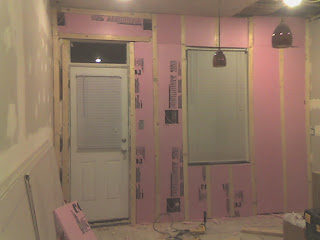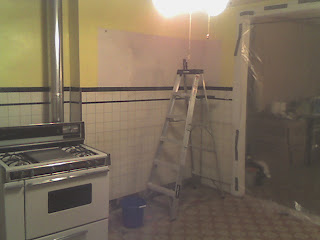

Wow! It's been a while since I've updated. I've been swamped trying to complete my renovation of the living room/dining room, so I haven't really had time to post. But, thanks to some insomnia, I've got a little extra time to post tonight.
As you can see from the above picture, I finished hanging the drywall, then taped the seams and spackled over the screw holes.
A couple lessons learned. First. Buy a drywall bit. It has a collar on it that stops the bit from driving the screw through the paper on the face of the drywall, and makes a perfect, easily concealed dimple. Second. Use drywall screws. I had leftover decking screws from the subfloor, which looked identical to drywall screws, but they weren't. The collar is different, and causes the drywall paper to rip before the screw is set below the surface of the paper, making a hole that is much more difficult to conceal.
Also, though it is hard to believe, the paper is one of the key structural elements of drywall - when it is ripped, it weakens the drywall in that spot. Thus, a screw that is sunk too far and rips the paper is as good as no screw at all.
As for the taping and spackling, it is definitely an art form. It took me a long time to get it right. I have a newfound respect for drywall professionals who can work so quickly. It simply entails using paper tape to cover the joints of the drywall sheets, then spackling over the tape and, over several coats, feathering out the spackle to minimize, and ideally, eliminate, the visibility of joints and screw holes.
Once the last coat of spackle is applied, it is sanded. This can be an extremely dusty affair. I borrowed a gadget from a coworker that hooks up to a shop-vac and uses a 5-gallon bucket filled with water to trap the drywall dust as you're sanding. It worked great but it was a little irritating to have the shop vac running the whole time I was sanding. Probably did a number on the electric bill too.

As you can see at left, I primed the walls next. Primer is necessary for new drywall, as it acts as a barrier to keep the paint from being absorbed. It's obvious when someone does not prime drywall before painting it because the texture of the paper is visible. Also, painting unprimed drywall consumes a lot more paint . Priming can also help conceal joints and screw holes.
As for the ceiling, I used Armstrong mineral fiber (same material as drop ceiling tiles) faux tin ceiling tiles. The existing ceiling was drywall over top the original plaster ceiling. It was pretty damaged from cutting the holes for the recessed lights, and it was textured in a way that I didn't really like. Also, because of the texture, it would have been nearly impossible to patch. New drywall for the ceiling was an option but because I was a drywall novice, I decided against it.

The tiles were not actually yellow, that's just the light reflecting from the walls. Also, though I never photographed it, a couple coats of paint with a thick nap roller virtually eliminated the seams that are visible in that picture.

The tiles, while substantially pricier than drywall (about $2.25/sq. ft.) are a breeze to install - they're tongue and groove, and can be stapled or glued up using construction adhesive (e.g., Liquid Nails) that is specifically formulated for "paneling". That formulation is extra tacky, and will hold the tiles up while the glue dries. Just be sure the ceiling is clean- I had an avalanche of tiles fall on me at one point where the glue didn't take because of dirt on the ceiling.
























